Recipe, pages 328-329.
Smoked short ribs smothered in barbecue sauce, with a side of sweet cornbread. That’s what it seems you’re eating, all in one big, surprisingly crunchy bite. This dish uses cayenne, paprika, chipotle and bell peppers, all forms of the chile pepper (capiscum).
I made this twice. Once served for guests, who loved the hard candy coating, but were taken by surprise that it was not barbecue sauce as it appeared to be! Then a second time to test the assembly with vegetable cubes instead of balls. The cubes worked better for me. Try it out for yourself, and let me know how you do!
Pork Belly
Pork belly is a pretty cheap cut of meat. It’s that fatty underside of the pig where bacon comes from. But it cooks up beautifully with time. Cured, you can buy it as salt pork. Earlier this week, on a whim, I asked the butcher at Whole Foods if he had pork belly.
“Pork belly? Naaaah, we don’t got dat here,” he exclaimed. “It don’t sell.”
“Can’t sell it?” I asked, a little not-so-surprised, but yet still dumbfounded. The price points are probably way too low for Whole Foods corporates to even consider.
“Ah, people just don’t know how to cook it!”
Gotta cook it slowly over time until it’s oh-so-melt-in-your-mouth tender — like other “unwanted” cuts of meat: beef cheeks, tongue, etc.
Day One
I read on blog that you should buy pork bellies taken from the female pig, rather than those of the male, as the latter can have a pronounced “gamey” stench. Lo and behold, the bellies I got — teats and all — were stinky. So I was definitely not going to keep the skin-on.
I get mine at Ranch 99, a local Asian market, for US$1.49 a pound. They’re layered with just enough, but not too much, fat.
Tip: Cut off the outer layer of skin, so any bad “aromas” present will not permeate the rest of the cut when cooking, unless you get a clean cut. I removed the skin, a bit of extra fat, rinsed and dried the meat thoroughly. Then divided the cut into three portions.
Chipotle-Paprika Salt Cure
“Chee potelay!” You may ask, “what’s that?” It’s one of my favorite spices, I use it all the time. Specially in salsas frescas.
About Chipotle
The chipotle (chee-POTE-lay) is a dried chile (“chile” is the Mexican spelling, but it’s also spelled “chili” and “chilli”) pepper that’s been dried over smoke. This imparts a rich, dark flavor to the chile. Jalapeño peppers are not the only kind of chile peppers used for chipotle — there are many varieties of chipotle available. I use the chile ahumado, a large, dried brownish pepper available in my local Mexican markets.
I didn’t have any powdered chipotle, but I did have some whole dried in the pantry. So I powdered it in the food processor.
Whole, dried chipotle chile ahumado peppers:
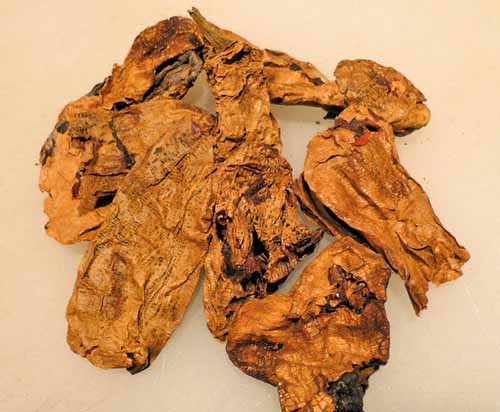
I combined the salt, chipotle and paprika together, and packed it around the pork bellies in a glass pan, covered and refrigerated.
I cured the bellies in the salt mix for two days.
Ingredients:
C&H cane sugar
Diamond Crystal kosher salt
Smoked paprika powder
Chipotle chile powder
Pork belly, from Ranch 99 Market
Day Two
 Pickled Carrot
Pickled Carrot
We’re going to make pickled carrots! They won’t be the spicy Mexican kind, zanahorias picantes, but more along the lines of Italian giardiniera, but you could easily add a few jalapeño chile slices to the pickling liquid for that extra kick. Mise en place:
I peeled a couple of large carrots. I took my smallest Parisienne scoop, a tomato “shark,” and scooped out as many balls of carrot I could and reserved.
Combined the sugar, vinegar and water in a small pan and brought to a boil, then poured over the carrots. Covered and refrigerated for a day.
Ingredients:
Large organic carrots, from Whole Foods
C&H cane sugar
White wine vinegar
Water
Smoked Paprika Tuile
What’s a tuile? Pronounced “tweel” (French for “tile”), a tuile is a thin, crisp cookie placed over a rounded object — like a rolling pin — while still hot from the oven. Once cooled and stiff, the cookie resembles a curved roof tile.
The classic tuile is made with crushed almonds but the cookie can also be flavored with orange, lemon, vanilla or other nuts. But this tuile is more like a brittle, which will be melted over the pork. Kinda like cheese on a hamburger.
I added the fondant, glucose and Isomalt together in a medium saucepan. Fondant’s easy to make, here’s the recipe I use.
And brought it to a boil, until it hit 160ºF like in the book. That temp came up awfully fast.
Poured the sugar syrup onto a prepare sheet tray. And let set. And let set. And let set.
But it didn’t harden up. I got taffy.
This is where you need to have some smarts about cooking sugar, candymaking, sugar syrup temperatures, etc. I checked the other recipes for “tuile” and saw that they required 320-325ºF (160ºC). There’s the typo. Turns out, you need to heat up the sugar syrup to the hard crack stage, or about 325ºF (160ºC).
Errata
Cook the sugar until it reaches 325ºF (160ºC), not 160ºF.
So I melted it again, and heated until it reached 325ºF (160ºC). It liquified again very easily.
It started turning a brownish color just as it hit 320. Poured back onto the prepared sheet tray and cooled again.
It hardened to a brittle. That’s more like it! Once cooled, I cracked the thing up with the metal heel of my kitchen knife.
And placed the shards into my food processor. The beautiful color of the sugar almost reminded me of stained glass.
I pulverized the shards into a powder for several minutes, until it seemed to be smoking. That was just the sugar dust in the air.
Then I transfered the powdered sugar mix to a bowl and quickly mixed in the paprika and cayenne pepper.
You want to do this rapidly, as the humidity in the air cakes up the sugar. I could feel it caking up as I mixed! Here’s what it looked like the next day:
Once mixed, put into a sieve, and sifted into a 2-inch x 2-inch template placed on a clean, silpat-covered sheet tray.
The template I had cut out from a 1/8″ thick foam-core board.
Space out so you get at least eight 2″ x 2″ x 1/8″-thick squares of the powder. They’ll start to “cake-up” as soon as you lift the template off your prepared sheet tray. In fact, you can even move them around the tray a bit without breaking their forms…
Then bake for about “30 seconds on each side, turning.” Ha! It’s molten sugar! I tried, and messed up royally. So I just watched them carefully and took out when melted. If you leave them in too long, they’ll bubble and holes will appear in the mini-sheets. If this happens, never fear, take an offset spatula to them to smooth out while the sugar is still liquid.
Removed to cool again, and set aside in my prep area.
Ingredients:
Fondant paste
Glucose (Karo corn syrup)
Isomalt powder
Sweet smoked paprika powder
Cayenne pepper powder
Day Three
Cooking the Pork Belly
I think I cure them too long, as they turned out just a bit too salty. Next time, I’ll try it for a day only. As it cures, all its juices are drawn out into the salt. The pork dries out and takes on the smoky aroma of the peppers — like spicy smoked bacon.
I cleaned the salt off under the tap, and patted each belly dry. Cured bellies:
Then sealed each portion in a vacuum bag with the FoodSaver.
I cooked the cured pork bellies en sous vide for 4 hours at about 190ºF.
Then plunged the bags in ice water to halt the cooking, and refrigerated until my guests arrived.
Cucumber
I peeled a large cucumber. Using my small Parisienne scoop, I scooped out as many balls as I could and reserved to the prep area.
Ingredients:
English cucumber, from Whole Foods
Red Pepper
I cut up a red bell pepper, removing the seeds and interior “pith.” Cut a square and laid it flat. Then cut up one-eighth-inch squares out. And reserved to the prep area.
Ingredients:
Organic red bell pepper, from Whole Foods
Polenta (po-LEN-tah) is just Italian for “cornmeal.” Some of it’s lighter, some yellower, some fine, some coarse ground. You could use grits or plain old cornmeal just as easily.
Mascarpone (mass-car-POH-nay) is a type of Italian sweet cream cheese, usually the consistency of a sour cream.
I added the polenta to the water in a small saucepan and boiled until almost dry. Not enough water, had to add a bit more for my coarse polenta.
Errata The recipe says to use 13g salt, That’s waaay too much! Just use a pinch or two, or salt to taste.
Took it off the heat and added the butter, a few cubes at a time, then added the mascarpone. Whipped until creamy. Salted to taste.
Now THAT’S the way to make cornmeal mush for in the morning!
Set aside to the prep area.
Ingredients:
Polenta
Water
Diamond Crystal kosher salt
Challenge unsalted butter, cubed
Mascarpone cheese
To Assemble and Serve
When it was time for dinner, I removed the bellies, bell pepper squares, cucumber balls and pickled carrots from the fridge. I cut up the pork into one-inch squares, trying to make sure that they were mostly meat. Here are three beauties:
Seared on high heat to get a crispy exterior.
And was ready to plate!
I spaced the seared pieces of pork belly onto a small griddle, which I’ll use to hold them under the broiler later.
Assembling these the first time had been a bit of a disaster. I used the smallest scoop (tomato shark) I had. I carefully placed 2 cucumber and two carrot pieces onto the flat tops of the seared pork bellies. Then added two pieces red bell pepper in between these. Now, I had to place a slab of the paprika tuile on top of these. I pushed down too hard once and all the veggies shot off like so many Jengos. This was not working. My carrot and cucumber balls were too big.
Here’s a picture of the first batch I tried on some friends. These are the big-balled versions. The tuile just didn’t want to cover em all up…
The balls of veggies made it even more difficult, so I decided to cube EVERYTHING for my second batch. Tried it again the next day, but balanced the tuiles very carefully, and they rested much flatter.
I held the griddle with the pork bellies under the broiler until the tuiles melted, and covered the meat cubes.
Now they looked great — like DUPLOs smothered in BBQ sauce — and were hot for service!
I put a dollop of polenta on each dish, then set a pork belly cube in each. Topped with some small, fresh sprigs of marjoram from my garden. Hint: look for the smallest leaves at the base of the marjoram plants.
And served!
Ingredients:
Small, fresh marjoram leaves with stems attached
Serveware:
Pedestal serving piece (US$6.00 ea), by Crucial Detail, available from J.B. Prince
or
Small square serving dish (US$1.55 ea), from Marukai
or
Any old small plate or dish
Equipment:
Salter digital scale
Measuring bowls
Kitchen knife, cutting board
Stainless mixing bowl
Cuisinart small food processor
Small and medium saucepans
FoodSaver vacuum sealer and bags
Large pot and thermometer
Wire whisk
Rubber spatula
Plastic wrap
Plastic containers
Griddle and oven mitt
Sheet trays
Silicone mats
Tweezers
Yields: About 16 servings, but double up the recipe for polenta
Next, TUNA, Candied and Dried
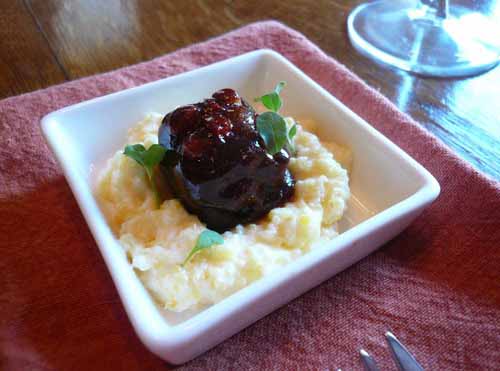
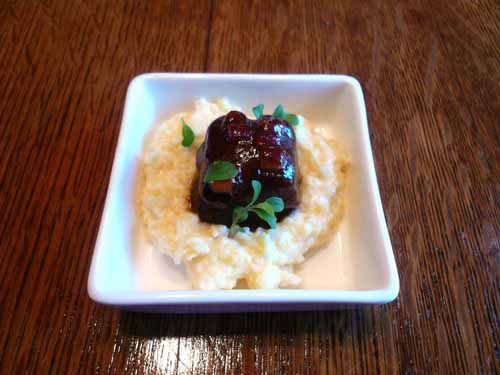
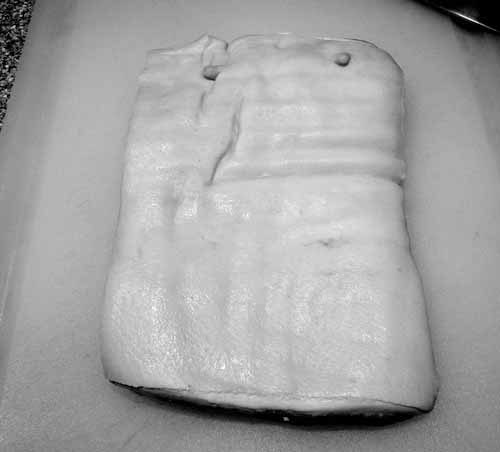
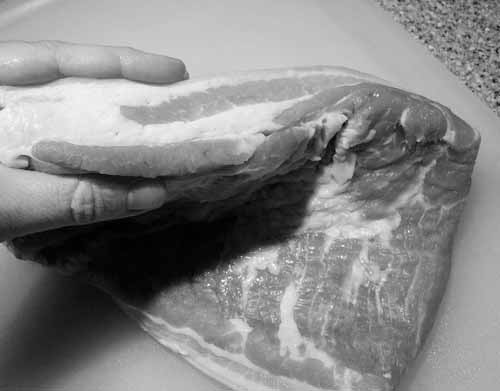
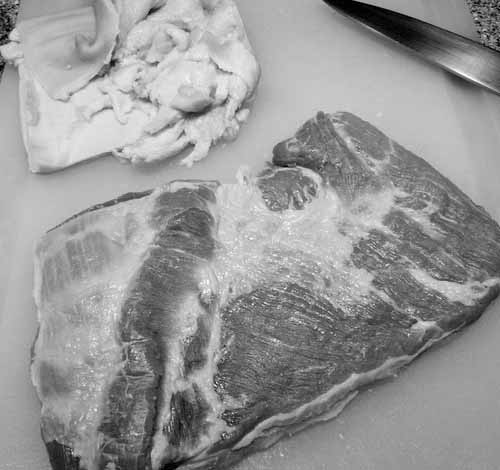
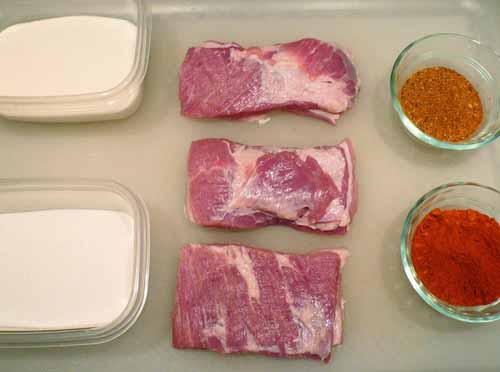

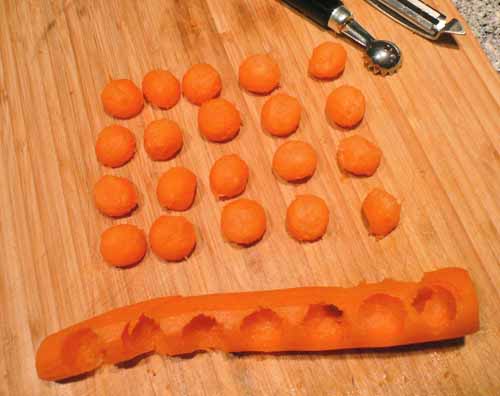


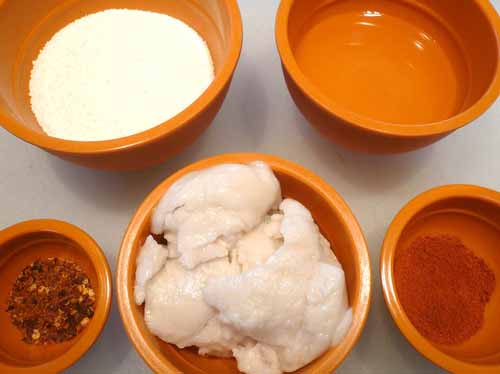

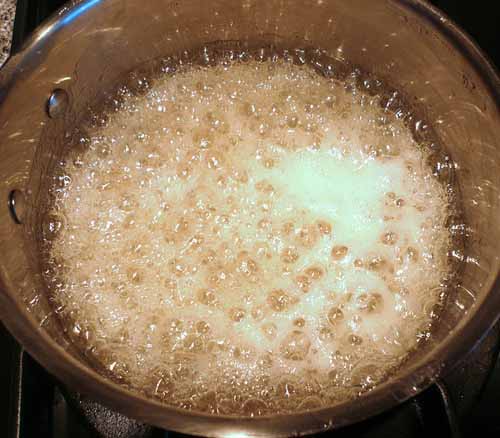
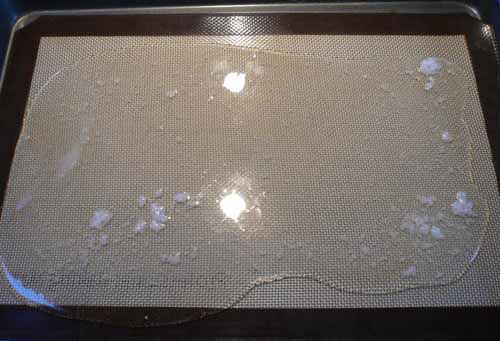

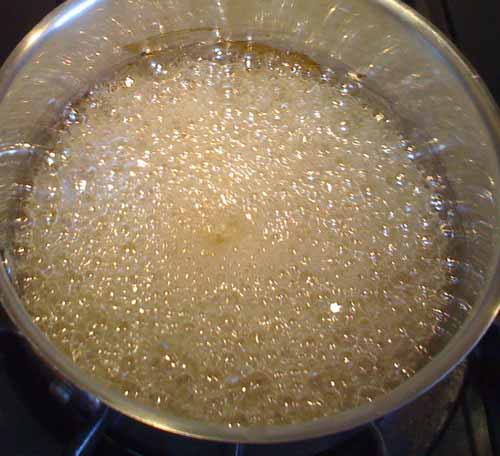

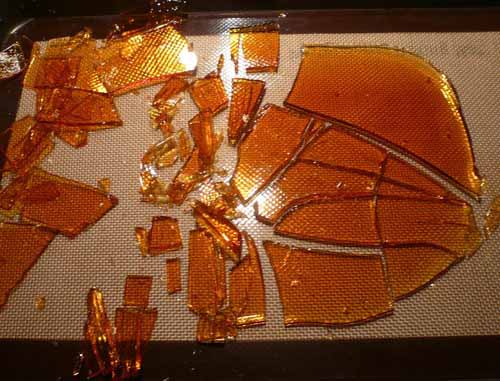
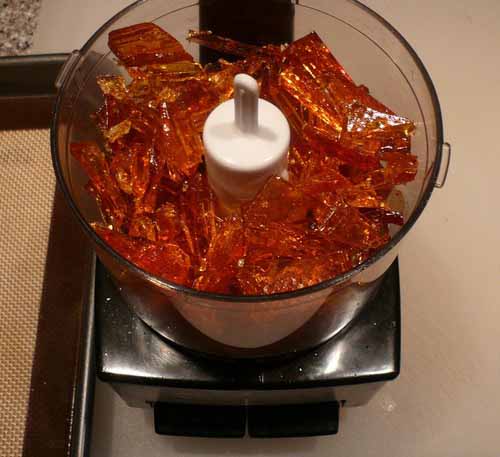

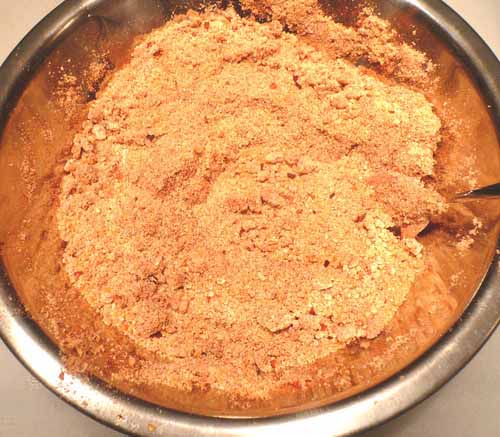
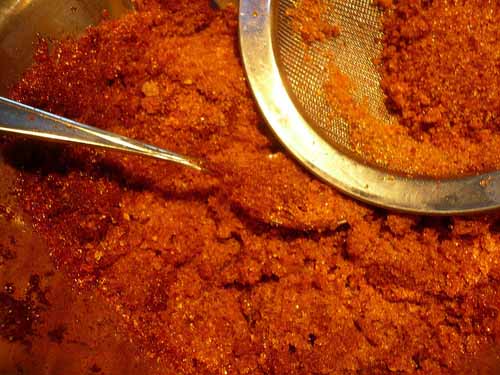
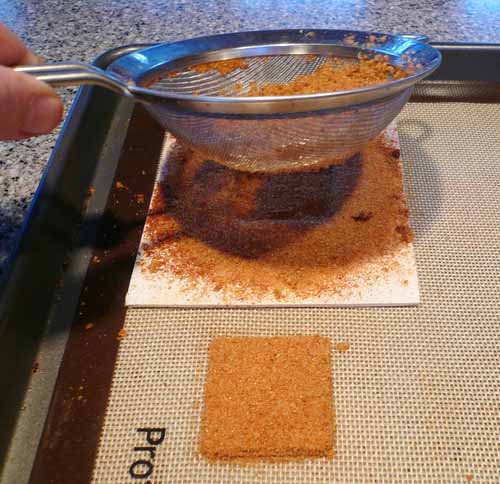
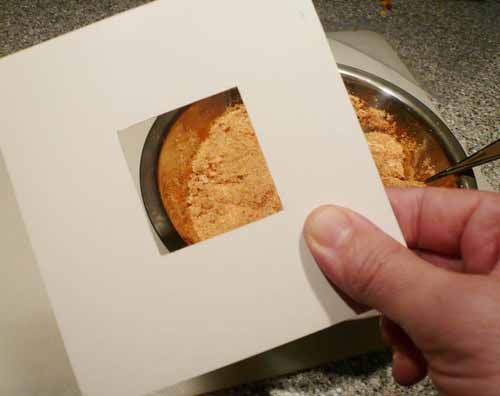
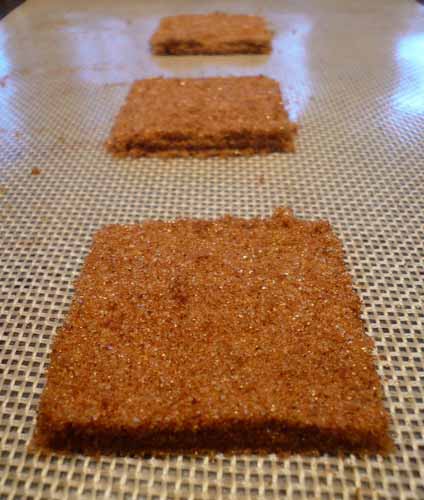

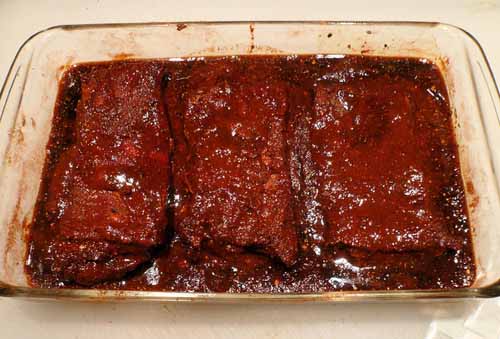

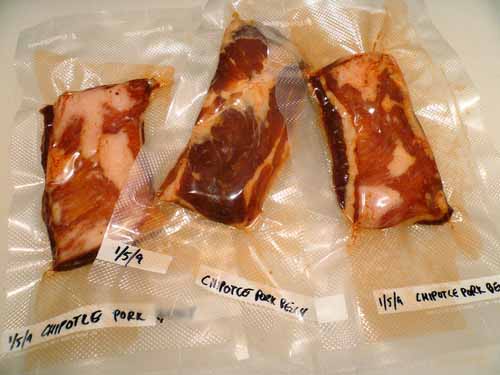
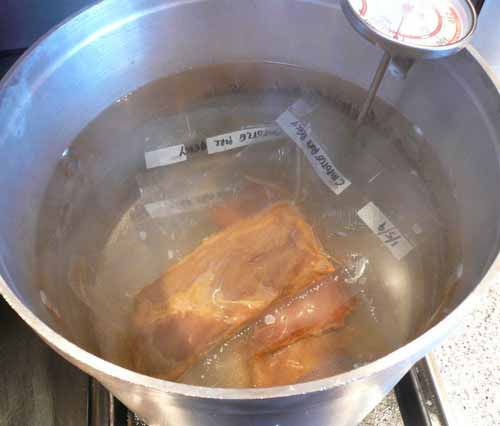




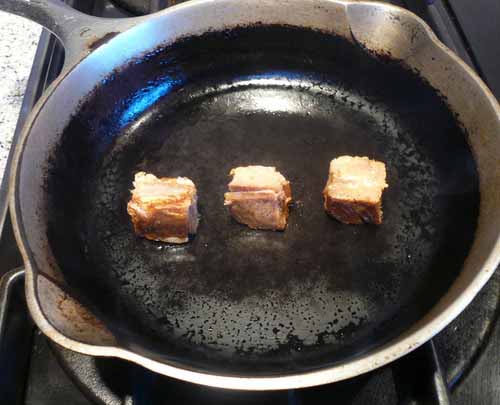
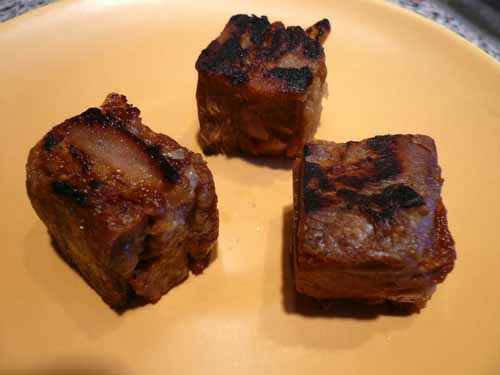
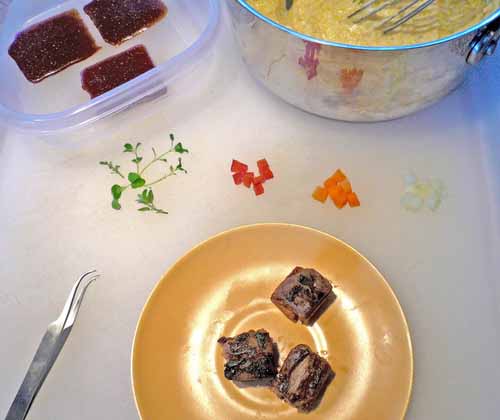

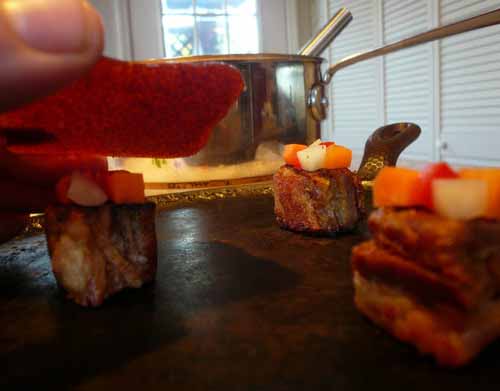
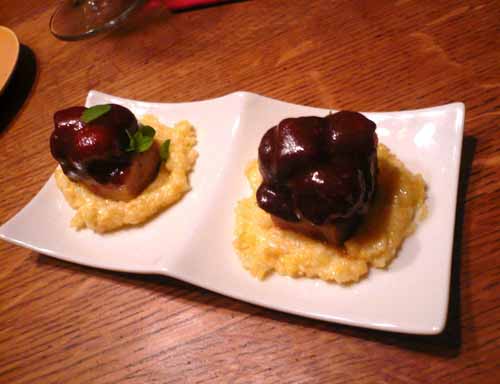
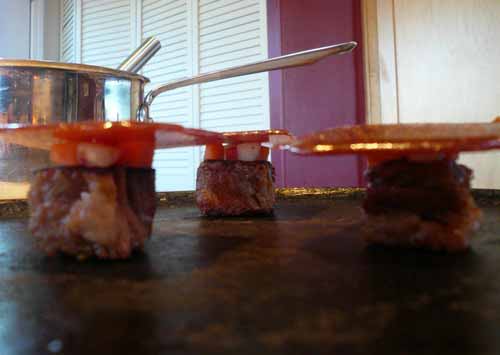
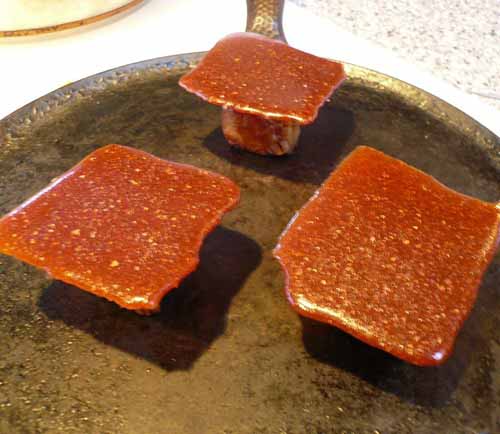

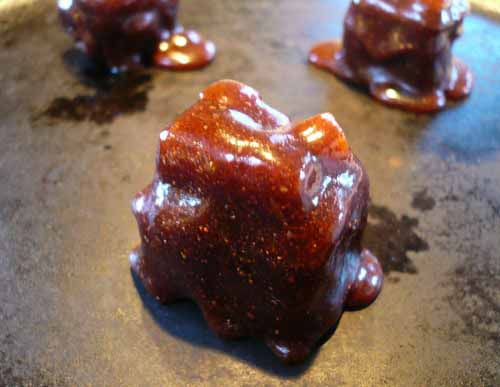
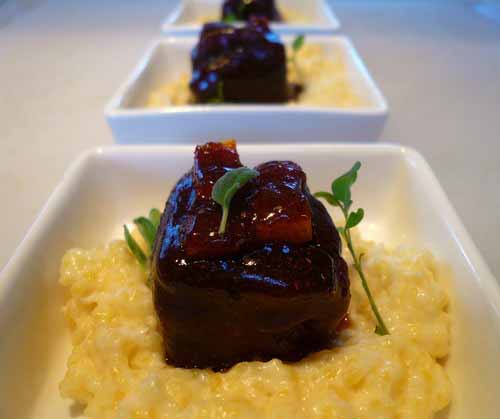

19 Responses to PORK BELLY, Pickled Vegetables, BBQ Sugar, Polenta